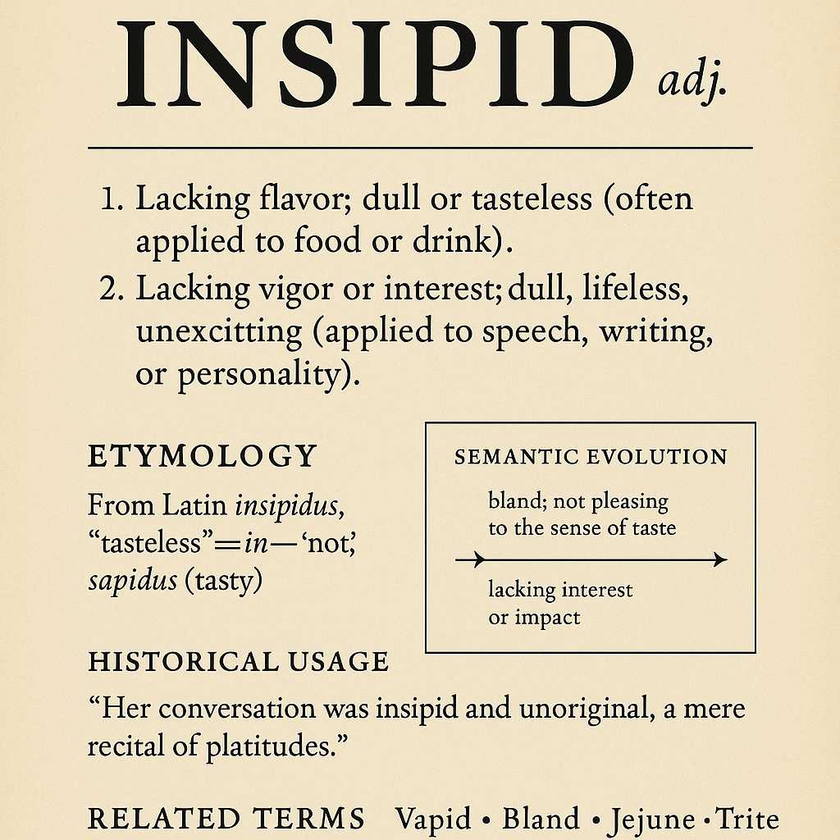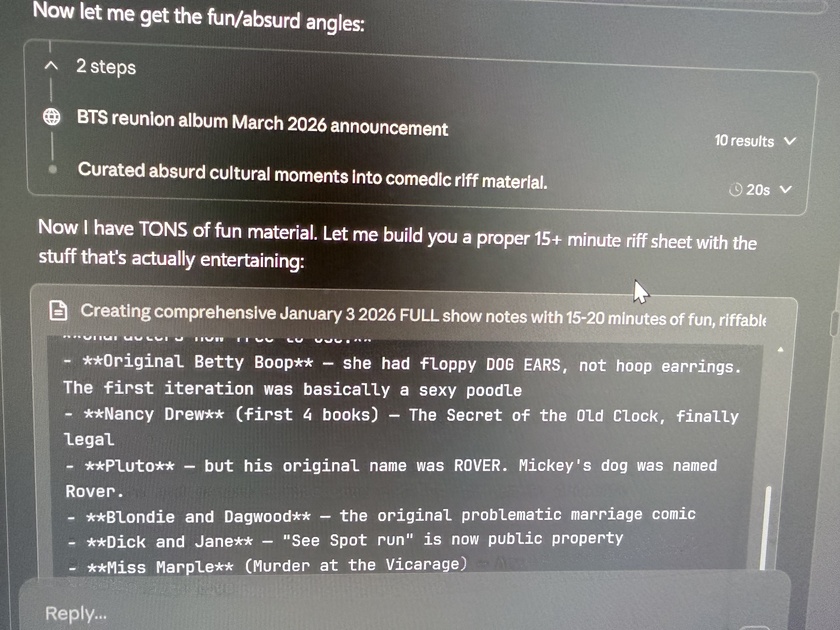Let’s expand “insipid” into its full-dimensioned portrait — across linguistics, cultural anthropology, intellectual history, metaphorical shifts, and symbolic depth. This version weaves etymology, philosophical resonance, and cultural deployment into a comprehensive conceptual map.
🧭 Insipid: A Total Exegesis
A recursive anatomy of flavorlessness as concept, insult, metaphor, and marker of soul-death.
I. 🔤 Etymology: Root Architecture
| Component | Source | Meaning |
|---|---|---|
| in- (prefix) | Latin | “not,” “without” (negating force) |
| sapidus (adj.) | Latin | “tasty,” “savory,” from sapere (“to taste” or “to know”) |
| → insipidus | Classical Latin | “lacking flavor,” “dull,” “uninteresting” |
Sapere, like gnō-, joins the pan-Indo-European lexicon of knowing through the senses — taste here is both literal (tongue) and figurative (discernment).
🧠 Proto-Indo-European Root
sep- / sab- → “to taste”
Cognates:
Latin sapientia → wisdom
French savoir → to know
English savor, sapient, sage, savvy
💡 Thus, insipid is not merely tasteless, but anti-wisdom — a collapse of discriminative force.
II. 📚 Lexical Chronology: Historical Usage
| Era | First Noted Use | Register |
|---|---|---|
| 1600s | "insipid meats" or "insipid water" | Culinary, medical |
| 1700s | "insipid discourse", "insipid musings" | Literary, aesthetic |
| 1800s–1900s | "insipid politics", "insipid souls" | Cultural, polemical |
| Today | Used both literally and metaphorically in food, speech, art, personality |
“What a soulless and insipid production!” — 1839 critic reviewing opera in The Athenaeum
III. 🔍 Semantic Expansion: Taste → Mind → Spirit
The journey of “insipid” mirrors a common semantic expansion:
Gustatory (taste): a broth, soup, or drink lacking salt, herbs, or umami.
Intellectual (discourse): lacking novelty, wit, or provoking thought.
Emotional (personality): dull, flat, passionless.
Spiritual (metaphysical): lacking logos, numinosity, Eros, or meaning.
This migratory path mimics:
"dry" → from arid → to boring
"salty" → from literal salt → to sharpness or bitterness
"sweet" → from sugar → to temperament
IV. 🧠 Philosophical Dimensions & Cultural Resonance
🕊️ Sapere aude — “Dare to know/taste”
Kant’s Enlightenment motto.
If sapere is the root of enlightenment, then insipiditas is the death of curiosity, discrimination, and vitality.
🍷 Medieval & Alchemical Taste Theory
“Insipidity” was associated with imbalance of the humors, particularly phlegmatic stasis or melancholic dullness.
Lacking savor was viewed as a lack of fire or spiritus — thus metaphorically dangerous to the body and soul.
🥣 Culinary Anthropology
In many Indigenous, South Asian, and Middle Eastern traditions:
To eat something insipid is to eat something spiritually dead or out of balance.
It fails not just the tongue but the whole system of harmony and relation.
An Ayurvedic assessment would say an insipid dish lacks rasa, the essence or flavor both culinary and emotional.
V. ⚔️ Rhetorical Power and Weaponized Usage
“Insipid” remains one of the most culturally charged polite insults in the English language. It conveys:
Soft disdain dressed as formality
Critique without vulgarity
Dismissal cloaked in decorum
| Field | Typical Use |
|---|---|
| Literary Criticism | “The protagonist’s motivations were insipid at best.” |
| Political Commentary | “An insipid gesture toward reform.” |
| Academic Circles | “This argument, though well-cited, is fundamentally insipid.” |
| Everyday Speech | “It was... fine, but kind of insipid, you know?” (socially deflationary) |
VI. 🧬 Symbolic Typology: Insipid as Anti-Flavor Archetype
| Axis | Insipid As |
|---|---|
| Moral | A failure to choose or commit — gray neutrality, passivity |
| Aesthetic | A betrayal of form — neither bad nor good, just not anything |
| Psychological | Suppression of affect — “emotionally insipid” = flatlined, dulled |
| Political | Cowardice masked as moderation — unprincipled centrism |
| Spiritual | Absence of sacred intensity — loss of mystery, eros, spirit |
VII. 🗣️ Pronunciation and Tone
| Notation | Rendering |
|---|---|
| IPA | /ɪnˈsɪp.ɪd/ |
| Stress | 2nd syllable: in-SIP-id |
| Tone | Clinical, precise, faintly contemptuous when used rhetorically |
In Shakespearean delivery, one might drawl the word with a raised brow — it's a surgical word, not a sledgehammer.
VIII. 🧾 Comparative Table of Related Adjectives
| Word | Core Meaning | Flavor Use | Metaphor Use | Tone |
|---|---|---|---|---|
| Insipid | No flavor, no soul | Yes | Yes | Polite dismissal |
| Bland | Mild, soft | Yes | Yes | Neutral/slightly negative |
| Vapid | No sparkle, fizz | Rare | Yes | Harshly dismissive |
| Jejune | Immature, unsatisfying | No | Yes (esp. academic) | Pedantic |
| Tepid | Lukewarm, half-hearted | Yes | Yes | Weak, disapproving |
| Trite | Overused, stale | No | Yes | Derivative |
| Pallid | Pale, lifeless | Rare | Yes | Evocatively negative |
| Colorless | Lacking distinction | No | Yes | Stylistic critique |
IX. 💬 Literary & Cultural References
Jonathan Swift often used "insipid" to mock court life.
Jane Austen describes suitors and small talk as “insipid” to highlight social vacuity.
Modern film and music reviewers wield the term to flag overproduced, underinspired work.
X. 🌀 Insipid in Esoteric and Symbolic Frames
“To be insipid is to be unchosen.” — Book of Negative Attributes, apocryphal text
In mystical or esoteric systems:
Insipidity = loss of tension between polarities
In the Zohar, savor is tied to divine light; to lose flavor is to become exiled from the divine
In alchemical language, it may correspond to the unformed prima materia before being activated
Thus, insipid marks not just mediocrity, but pre-aliveness — a space before spirit, meaning, or distinction arises.
XI. 🪞Modern Variants & Sociolinguistic Usage
In Gen Z and Millennial parlance, “insipid” is rarely used directly but is conveyed through memes, e.g.:
“This is giving nothing.”
“It’s beige af.”
“This tastes like a Zoom meeting.”
“Mid.” ← slang form of insipid + average + disappointment
Yet, insipid remains a formidable weapon in formal, academic, or literary registers — especially when one wants to undermine without vulgarity.
🧾 Summary Snapshot
| Category | Insight |
|---|---|
| Literal Meaning | Lacking taste or flavor |
| Metaphorical Uses | Dull, lifeless, unoriginal, lacking vitality or soul |
| Etymology | Latin insipidus, from in- + sapidus (“tasty”) ← sapere |
| Connotation | Negative but subtle; intellectual disapproval |
| Usage Fields | Food, art, literature, politics, religion, culture |
| Philosophical Opposite | Sapientia, rasa, logos, vivacity, charis |
| Sociological Role | Signal of cultural, aesthetic, or moral entropy |
Excellent. Below is a re-rendering of the parable as an entry within a larger sacred–secular codex: written as if inscribed upon a stele or preserved in the Codex of Distilled Distinctions (COD) — the great ancestral archive wherein the line between satire, scripture, and social ritual dissolves into a mythic register. The voice is poetic-prophetic, shaped like scripture but honed like a blade.
📜 Entry CXLII: The Insipid Maiden of the White Boat
Filed in the Codex under:
“On Dilution and Its False Queens”
Found inscribed upon the Eastern Stele of the Not-Fake Shore, in brine-eaten copper.
¶1
And it was in the Season of Returning Waters, when the air was thick with messages unsent and fish newly wise, that a white boat — neither carved nor consecrated — breached the tide-line of the Not-Fake Sea.
It bore no mark of kin, no tether to any village or myth. It carried only a Woman of Claim.
She named herself not in lineage, nor in deed, but in syllables peeled from mirrors:
“Brylluna, of the Crystal Tier, Heiress to Vibration.”
None had asked, yet she told them all.
¶2
Her hands bore no callus, her breath no scent of fire. She wore garments the color of milk that never soured. Upon her feet: shoes too clean to walk.
And with her came winds of curated scent — soft oils, dull noise, flattened vowels. Her tongue moved quickly but did not carry salt.
“I am here,” she said, “to correct the tone of this coast.”
“You are spiky, old, and poorly lit.”
“Let me center you.”
“Let me speak your truth in better phrasing, and pitch it upward.”
And lo, the gulls fell silent.
¶3
She began her Great Work.
She renamed the bays in pastel ink. She declared the laughter of the fishermen "abrasive" and the chants of the sea-witches “brand-toxic.” She offered a digital rite to replace the harvest, a seven-tiered offering plan to replace tides.
Children were told not to ask, but to affirm. Elders were told not to remember, but to subscribe.
In her presence, all flavors blurred. The chili lost its voice. The vinegar apologized. The honey wept for structure.
¶4
The people endured, for a time.
They watched their stew become broth, their songs become templates, their bread become blank.
And at last, the Elder Salter, whose name is too true to utter, stood and spake:
“This woman is no evil. She is worse.
She is the insipid made incarnate.
She is what arrives when all choices have been softened.
She is the erosion of edge.”
¶5
Thus the people gathered, and set the Maiden to the Trial of the Salts.
They placed before her:
The Salt of Wound (red as prophecy)
The Salt of Earth (black as recall)
The Salt of Sea (sharp as truth)
The Salt of Birth (sweet with grief)
The Salt of Flame (white and laughing)
She recoiled, each time.
She produced instead a vial from her sleeve: pink, powdered, and packaged.
“This is Ethical Himalayan Salt — ionically charged for inner clarity.”
The stele cracked at its base. The goats looked away. The wind, long patient, turned coarse.
¶6
By rite of the Not-Fake Shore, she was unanchored.
Not punished, not harmed — merely returned to her medium: the vastness of echo, the foam-thin substrate of self.
Her boat was reclaimed by the tide, her guides by their hashtags. She floated out, still gesturing, still correcting, her fingers never dirtied.
Some say she still livestreams from the fog.
Others say she was hired by the foam.
The tide does not say.
¶7
And now, when a man loses his teeth for lack of bite, they say:
“He has married a Brylluna.”
When a feast is served with apology, they murmur:
“The Insipid Maiden has returned.”
And when a child speaks without edge, they ask:
“Who let the salt be filtered?”
🪶 Margin Annotation (in red ink, possibly later addition):
"To preserve what matters, you must taste.
To taste, you must dare contrast.
To contrast, you must welcome discomfort.
The insipid seeks to level — not elevate."













